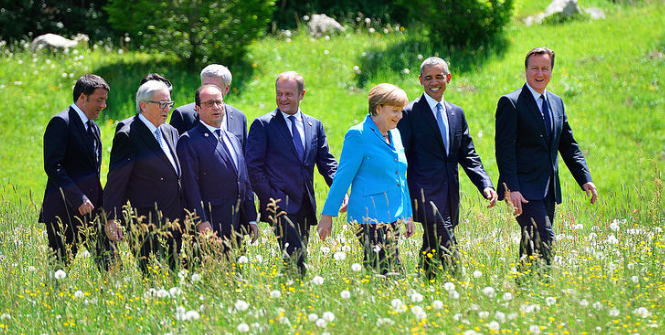The G7 is Right to Call for Fossil Fuel Phase-Out, But it Can Happen Sooner

The G7 nations, at this week’s summit in Germany, have called for “a decarbonisation of the global economy over the course of this century”. The question is how to best manage the transition, rather than whether it is possible or desirable.
The G7 nations, at this week’s summit in Germany, have called for “a decarbonisation of the global economy over the course of this century”. Of course, this group of nations is among those most heavily in favour of strong climate action, but the opportunities for climate-friendly growth are everywhere.
The G7 declaration supports a cut in global emissions at “the upper end” of the 40-70% range by 2050 recommended by the Intergovernmental Panel on Climate Change (IPCC), by “striving for a transformation” in energy production.
This call for decarbonisation is the right message, but on the wrong timescale. The low-carbon transformation needs to happen largely by the middle, not the end, of this century.
Transforming energy
The recipe for a low-carbon energy system has three essential ingredients, as set out in the global and Australian reports by the Deep Decarbonisation Pathways Project (of which I am a research partner).
First, achieve radical improvements in energy productivity – the amount of economic output per unit of energy use. Most aspects of most economies are far below the energy efficiency frontier. You’re probably reading this in a building that uses far more energy than necessary, and you might have travelled there in a relatively inefficient car. And depending on what industry you work in, there is a fair chance that it uses outdated equipment somewhere within its operation.
Second, take the carbon out of the energy supply. Crucially, that means replacing coal and gas in the electricity sector (and other industries) with renewable sources and nuclear power, and using carbon capture and storage where feasible.
Third, shift any direct fuel use to decarbonised electricity, for example by adopting electric cars and electric heating.
Added to this mix is the need to improve various industrial processes, as well as forest protection and carbon uptake on the land.
The toughest challenge
A carbon-free energy supply may seem difficult to achieve. Today, the world’s energy system is heavily based on fossil fuels: coal and oil account for about 30% each of total energy supply, and gas for another 20% or so. Low- or zero-carbon energy sources together account for the remaining 20%.
And yet the transition can be made, and without great cost if it’s done in smart ways. It will require a big change in investment patterns, but concentrated in a very small part of the global economy. The key is the falling cost of clean energy sources, especially renewable power, which allows a steady phasing out of the existing high-carbon infrastructure.
Each ageing coal-fired power station that comes offline needs to be replaced with renewable power and energy storage. The estimates of costs of reducing emissions have fallen significantly over recent years.
It can be done, and indeed it needs to be done much faster than the G7’s time frame of “over the course of this century”. To meet internationally agreed climate goals, decarbonisation needs to happen largely over the next three to four decades.
Most of the carbon-intensive infrastructure in the developed world will come to the end of its lifetime during that period anyway. The key is to stop building new fossil fuel infrastructure, and to support accelerated turnover to clean technologies.
Easy for the G7 to say?
Among the various clubs of nations, the G7 is perhaps the most receptive to calls for climate change action. It comprises the United States, the United Kingdom, Germany, France, Italy, Japan and Canada. Of these, only Canada relies heavily on fossil fuel exports, and the United States sees an advantage to its natural gas industry as a transition fuel that is cleaner than coal.
What’s more, each of the G7 countries has domestic industries that will benefit from a global energy transformation. From electric cars to nuclear power stations to smart grids, low-carbon is a giant business opportunity.
In fact, this kind of declaration is something that China might well also be prepared to sign. China sees the need to act on climate change, it wants to limit the use of fossil fuels – which would also cut air pollution and import dependency – and sees its industries as potential leaders in the energy technologies of the future.
As Nick Stern and Fergus Green of the London School of Economics argue in a paper released this week, China could reach its “peak CO2” by 2025 – meaning its emissions will begin to decline sooner than many have predicted. And where China goes, many developing countries are likely to follow.
These countries are likely to do so selectively: if low-carbon technology is desirable for development, governments will facilitate and support it; where traditional high-carbon options are cheaper and do not have large drawbacks they will continue to be attractive.
Show them the money
This is where climate finance comes in. The G7 nations have said that they remain committed to the pledge made at the 2009 Copenhagen climate talks to scale up climate finance to developing countries to US$100 billion per year by 2020. Much of that would be for climate adaptation rather than energy investment, and even the full amount, if it eventuates, will pale in comparison to annual investment needs in the energy sector alone. Still, finance from developed countries could help bring down the cost of low-carbon technologies and help make “clean” investments happen.
It will be difficult for the G7 and other rich countries to agree formally on who should pay how much, or even what to count as climate finance. But the commitment to provide climate finance itself may help, for example through decisions taken by government-backed development banks.
A greener shade of growth
The call for decarbonisation rest not on altruism but on forward-looking economic judgement. In international economic circles, the idea is taking hold that the economies of the future need to be less polluting and less materially intensive if growth is to be sustained. Economists are also realising that the low-carbon transition can itself can be a source of economic growth.
This thinking is elegantly captured in a report by the New Climate Economy project. It recurs in flagship reports by the OECD, statements by the World Bank – such as Indonesian finance minister Sri Mulyani’s speech this week calling for “inclusive green growth” – and the International Monetary Fund, which recently called for reform of fossil fuel subsidies.
As this thinking gains momentum and the success stories emerge, attempts by fossil fuel producers to slow the speed of the transition will increasingly lose traction. The question then becomes how to best manage the transition, rather than whether it is possible or desirable.
Frank Jotzo is the Director at the Centre for Climate Economics and Policy at Australian National University. This article was originally published on the Conversation on 10 June 2015. It is republished with permission.





